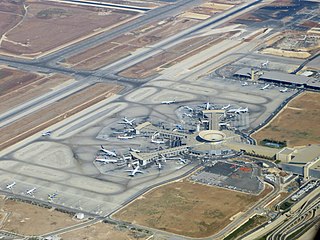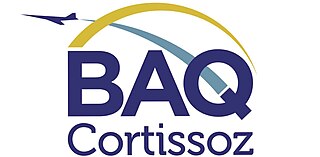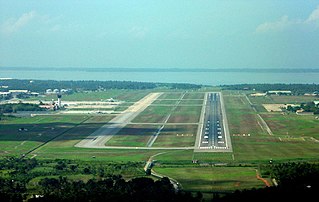
Ben Gurion International Airport, commonly known by the Hebrew-language acronym Natbag, is the main international airport of Israel. Situated on the northern outskirts of the city of Lod, it is the busiest airport in the country. It is located 45 kilometres (28 mi) to the northwest of Jerusalem and 20 kilometres (12 mi) to the southeast of Tel Aviv. It was known as Lod Airport until 1973, when it was renamed in honour of David Ben-Gurion (1886–1973), the first prime minister of Israel. The airport serves as a hub for El Al, Israir Airlines, Arkia, and Sun d'Or, and is managed by the Israel Airports Authority.

Ernesto Cortissoz International Airport is an international airport serving the area of Barranquilla, the capital city of the Atlántico department in Colombia. The airport is located in the suburban municipality of Soledad. It owes its name to one of the pioneers of Colombian aviation, Ernesto Cortissoz.

Frankfurt Airport, is Germany's main international airport by passenger numbers, located in Frankfurt, Germany's fifth-largest city. In the German Aeronautical Information Publication, its name is Frankfurt Main Airport. The airport is operated by Fraport and serves as the main hub for Lufthansa, including Lufthansa CityLine and Lufthansa Cargo as well as Condor and AeroLogic. It covers an area of 2,300 hectares of land and features two passenger terminals with capacity for approximately 65 million passengers per year; four runways; and extensive logistics and maintenance facilities.

Raleigh–Durham International Airport, locally known by its IATA code RDU, is an international airport that serves Raleigh, Durham, and the surrounding Research Triangle region of North Carolina as its main airport. It is located in unincorporated Wake County, but is surrounded by the city of Raleigh to the north and east, and the towns of Cary and Morrisville to the south. The airport covers 5,000 acres (20 km2) and has three runways.

Chhatrapati Shivaji Maharaj International Airport is an international airport serving Mumbai and the Mumbai Metropolitan Region (MMR). It is the second busiest airport in India in terms of total and international passenger traffic after Delhi, and was the ninth busiest airport in Asia and 25th busiest airport in the world by passenger traffic in fiscal year 2023–24.

Kuwait International Airport is an international airport located in the Farwaniya Governorate, Kuwait, 15.5 kilometers (9.6 mi) south of the centre of Kuwait City, spread over an area of 37.7 square kilometres (14.6 sq mi). It serves as the primary hub for Kuwait Airways and Jazeera Airways. A portion of the airport complex is designated as Abdullah Al-Mubarak Air Base, which contains the headquarters of the Kuwait Air Force, as well as the Kuwait Air Force Museum.

Bahrain International Airport is the international airport of Bahrain. Located on Muharraq Island, adjacent to the capital Manama and the city Al Muharraq, it serves as the hub for the national carrier Gulf Air. The airport is managed by the Bahrain Airport Company. Established in 1927, it is the Persian Gulf's oldest international airport.
Zayed International Airport, also known as Abu Dhabi International Airport, is the primary international airport serving Abu Dhabi, the capital of the United Arab Emirates (UAE). It is the second busiest airport in the UAE after Dubai International Airport, one of the busiest airports in the Middle East and is the hub for Etihad Airways as well as an operating base for Wizz Air Abu Dhabi and Air Arabia Abu Dhabi.

Cairo International Airport is the principal international airport of Cairo and the largest and busiest airport in Egypt. It serves as the primary hub for Egyptair and Nile Air as well as several other airlines. The airport is located in Heliopolis, to the northeast of Cairo around fifteen kilometres from the business area of the city and has an area of approximately 37 km2 (14 sq mi). It is the busiest airport in Africa and one of the busiest airports in the Middle East in terms of total passengers.

Doha International Airport is an airport in Doha, Qatar. It was Qatar's commercial international airport until Hamad International Airport opened on 27 May 2014. While all scheduled commercial traffic ceased, the airport site and existing runway are still used by Qatar Emiri Air Force, Qatar Amiri Flight, Rizon Jet, Gulf Helicopters and Qatar Aeronautical College. It also acts as a state/diplomatic airport catering to both Qatar Amiri Flight and state-visit flights. The airport welcomed commercial flights again on 15 September 2022 for selected airlines to handle increased traffic for the 2022 FIFA World Cup that Qatar hosted in November.
Middle East Airlines – Air Liban S.A.L., more commonly known as Middle East Airlines (MEA), is the flag carrier of Lebanon, with its head office in Beirut, near Beirut–Rafic Hariri International Airport. It operates scheduled international flights to Asia, Europe, the Middle East, and Africa from its base at Rafic Hariri International Airport.

Blue Wings AG was a charter airline based in Germany, focusing on serving Turkey, the Middle East and Russia from its base at Düsseldorf Airport. The headquarters were located on the airport property.

Shah Amanat International Airport, Chattogram is an international airport serving Bangladesh's southeastern port city of Chittagong. Operated and maintained by the Civil Aviation Authority of Bangladesh, it is the second-largest international airport in Bangladesh after Shahjalal International Airport in Dhaka, Bangladesh. It is used by the Bangladesh Air Force as a part of 'BAF Zahurul Haq Base'. It was formerly known as MA Hannan International Airport, named after Awami League politician M. A. Hannan, but was renamed on 2 April 2005 by the Government of Bangladesh, after an 18th-century Islamic saint, Shah Amanat. It is capable of annually handling 1.5 million passengers and 6,000 tonnes of cargo. It also serves as a base for the Arirang Flying School.

Bandaranaike International Airport (BIA) (Sinhala: බණ්ඩාරනායක ජාත්යන්තර ගුවන්තොටුපළ, romanized: Bandāranāyaka Jātyantara Guvantoṭupaḷa; Tamil: பண்டாரநாயக்க சர்வதேச விமான நிலையம், romanized: Paṇṭāranāyakka Carvatēca Vimāṉa Nilaiyam) (commonly known as Colombo International Airport, Colombo–Bandaranaike International Airport, and locally as Katunayake International Airport) (IATA: CMB, ICAO: VCBI) is the main international airport serving Sri Lanka. It is named after former Prime Minister S. W. R. D. Bandaranaike (1899–1959) and is in the suburb of Negombo, 32.5 kilometres (20+1⁄4 miles) north of the nation's capital and commercial center, Colombo.

Nội Bài International Airport in Hanoi, the capital of Vietnam, is the country’s second largest and busiest international airport for passenger traffic, after Tan Son Nhat International Airport in Ho Chi Minh City. It is currently the main airport serving Hanoi, replacing the role of Gia Lam Airport. The airport consists of two passenger terminals and a cargo terminal. Terminal 1 serves domestic flights, and Terminal 2 serves all international flights to and from Hanoi. The airport is currently the main hub of the flag carrier Vietnam Airlines, travel carrier Vietravel Airlines, and an operating base of budget carriers Bamboo Airways and VietJet Air.

Kuching International Airport (KIA) is an international airport serving the entire southwestern region of Sarawak, Malaysia. It is located 11 km (6.8 mi) south of Kuching city centre. The airport is colocated with the RMAF Kuching, home to the No. 7 Squadron RMAF.

Nursultan Nazarbayev International Airport, alternatively referred by its previous name as Astana International Airport until 2017, is the international airport serving Astana, Kazakhstan, the capital and second most populous city in the country. It is the primary aviation hub for northern Kazakhstan. Regionally, it stands as the second-busiest international air passenger gateway into Central Asia after Almaty International Airport (ALA). The airport is also the second-busiest airport in terms of total passenger traffic, air traffic movements and total cargo handled in Kazakhstan, with ~7,500,000 passengers served annually in 2023, a 25% increase compared with 2022, a new passenger record for the airport. On average, the airport handles more than 200 departures a day.
Rene Mouawad Air Base, formerly and still sometimes known as Qoleiat air base , used to be a military-civil joint airport in North Lebanon, 6 kilometres (3.7 mi) from the Lebanese–Syrian border.

Jinnah International Airport, formerly Drigh Road Airport or Karachi Civil Airport, is Pakistan's busiest international and domestic airport, and handled 7,267,582 passengers in 2017–2018. Located in Karachi, the largest city and commercial capital of Pakistan and capital of the province of Sindh, it is named after Muhammad Ali Jinnah, the statesman founder of Pakistan. It is one of the oldest airports in the world.

Muscat International Airport, formerly Seeb International Airport, is the main international airport in Oman and is located in Seeb, 32 km from the old city and capital Muscat within the Muscat metropolitan area. The airport serves as the hub for flag carrier Oman Air and Oman's first budget airline, Salam Air, and features flights to several regional destinations as well as some intercontinental services to Asia, Africa and Europe.

























